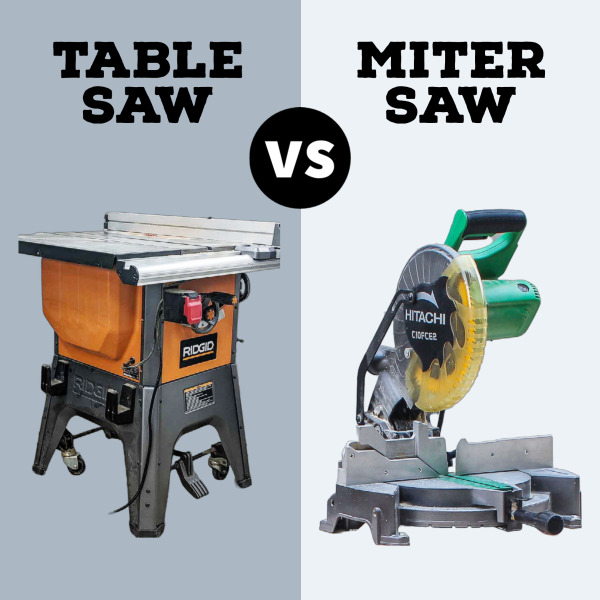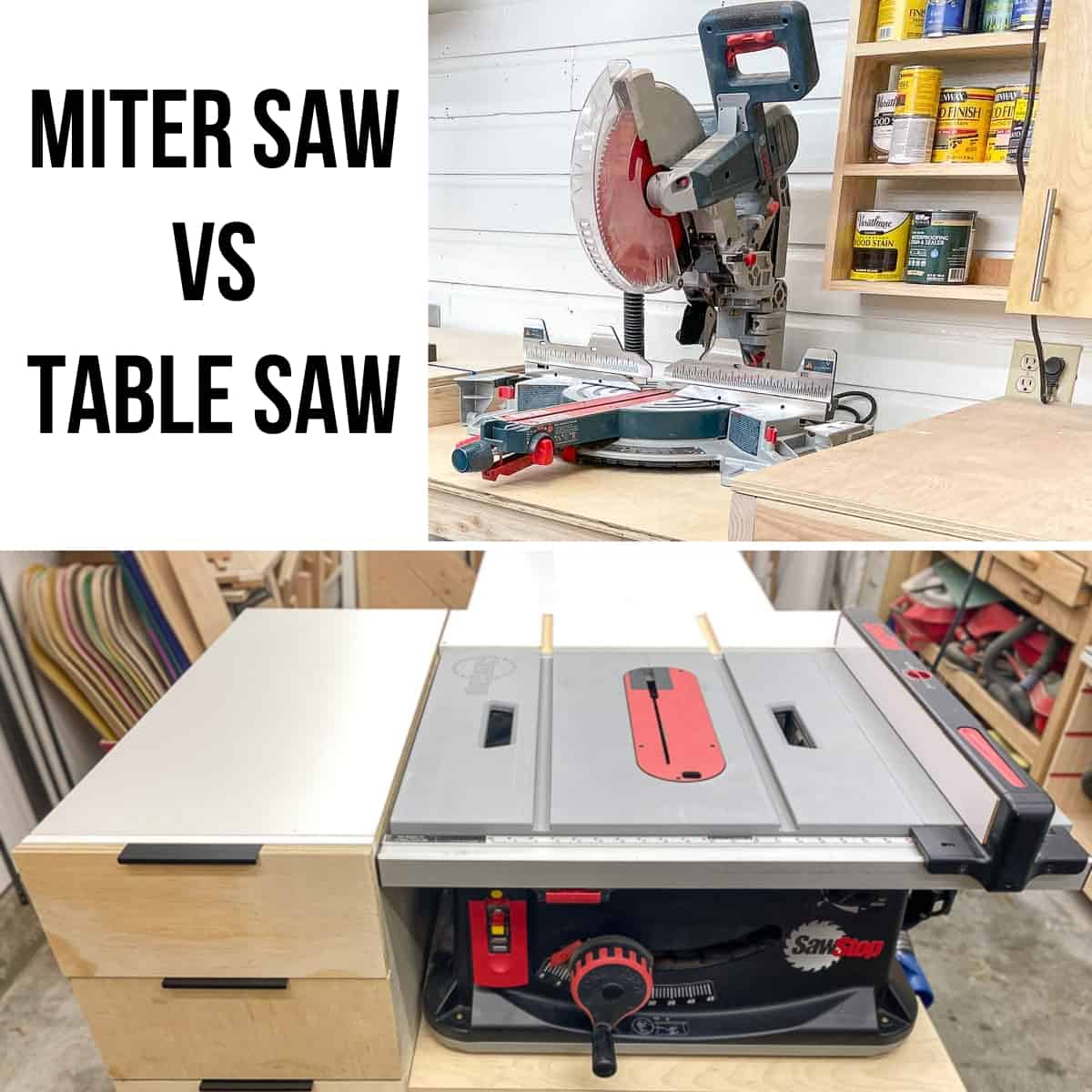Can a table saw replace a miter saw? If you’re a budding woodworker or a DIY enthusiast, you’ve probably wondered if you can get away with just one tool instead of investing in both. Well, let’s dive into this topic and find out if the mighty table saw can truly do the job of a miter saw.
Now, table saws and miter saws are both incredibly useful tools, but they have distinct purposes. A table saw is great for ripping large boards, cutting long straight lines, and creating dado cuts. On the other hand, a miter saw excels at making accurate crosscuts, miter cuts, bevel cuts, and compound cuts.
So, the question remains: can a table saw replace a miter saw? Let’s explore the differences, similarities, and practicality of using a table saw for miter saw tasks. Get ready to uncover the answer and discover which tool suits your woodworking needs best. So, let’s get sawing!

Can a Table Saw Replace a Miter Saw?
Whether you’re a seasoned woodworker or a DIY enthusiast, you’ve probably come across the question: “Can a table saw replace a miter saw?” Both tools serve different purposes in the workshop, but they do have some overlapping functionalities. In this article, we’ll explore the capabilities of each tool, discuss their similarities and differences, and help you determine if a table saw can indeed replace a miter saw in your woodworking projects.
The Capabilities of a Table Saw
A table saw is a versatile woodworking tool that provides precision and power for a variety of cutting tasks. It consists of a circular saw blade mounted on an arbor, which is powered by an electric motor. Table saws are known for their ability to cut straight lines, rip boards, make crosscuts, and perform bevel cuts.
One of the main advantages of a table saw is its large, flat work surface, typically in the form of a table or a stand. This stable surface allows for accurate and consistent cuts, especially when working with longer pieces of wood. Furthermore, table saws often feature a fence system that enables precise parallel cuts.
While a table saw offers many cutting options, it does have some limitations. It may struggle with making angled cuts or accurately cutting smaller pieces due to the large table size. This is where a miter saw comes into play.
The Capabilities of a Miter Saw
A miter saw, also known as a chop saw or a drop saw, is designed specifically for making precise angled cuts, commonly known as miter cuts. It consists of a circular saw blade mounted on a pivoting arm and is typically used for making crosscuts, miter cuts, bevel cuts, and compound cuts.
One of the main advantages of a miter saw is its ability to make quick and accurate cuts at various angles. It is commonly used for cutting frames, moldings, trim work, and other applications that require precise mitered or beveled cuts. The miter saw’s compact size and the rotating arm allows for efficient cutting of smaller pieces of wood as well.
However, compared to a table saw, a miter saw may have limitations when it comes to rip cuts or cutting wider boards due to its fixed cutting width. This is where a table saw shines, making it a more suitable choice for certain applications.
The Similarities and Differences
While a table saw and a miter saw may have different functionalities, they do overlap in some areas. Here are some important similarities and differences to consider:
Similarities:
- Both tools use a circular saw blade for cutting wood.
- They provide accurate and clean cuts when used correctly.
- Both can be used for making crosscuts and bevel cuts.
Differences:
- A table saw excels in rip cuts and cutting wider boards, while a miter saw is ideal for making precise angled cuts.
- A table saw offers a larger work surface and a fence system for parallel cuts, while a miter saw is more compact and efficient for cutting smaller pieces.
- A table saw allows for more versatility in terms of cutting tasks, while a miter saw is specialized for miter cuts and bevel cuts.
Based on these similarities and differences, it’s clear that while a table saw and a miter saw have some overlapping capabilities, they serve different purposes in the workshop. In some cases, a table saw can partially replace a miter saw for certain cutting tasks, but it may not entirely replace its functionality.
When to Use a Table Saw and When to Use a Miter Saw
Now that we have a clear understanding of the capabilities and differences between a table saw and a miter saw, let’s discuss when it’s best to use each tool:
Table Saw:
A table saw is the go-to tool for straight line cuts, rip cuts, and cutting wider boards. It’s best suited for tasks such as ripping plywood, cutting large panels, or creating long, straight cuts. The table saw’s fence system ensures accurate parallel cuts, making it an essential tool for precision woodworking.
Miter Saw:
A miter saw is the tool of choice for making angled cuts, miter cuts, bevel cuts, and compound cuts. It’s perfect for projects like cutting trim work, molding, or creating accurate mitered joints. The miter saw’s ability to pivot and make precise angled cuts makes it an invaluable tool for carpentry and finishing work.
When Both Tools Are Needed:
In some cases, you may find that having both a table saw and a miter saw in your workshop is essential for tackling a wide range of woodworking projects. The table saw excels in straight cuts and ripping large boards, while the miter saw is best for angled and mitered cuts. By having both tools, you can ensure versatility and efficiency in your woodworking endeavors.
Can a Table Saw Replace a Miter Saw? – Key Takeaways
- While a table saw can handle some tasks that a miter saw can do, they are not entirely interchangeable.
- Table saws are great for making straight cuts, but miter saws excel at making accurate angle cuts.
- Table saws are more versatile, allowing for different types of cuts, but miter saws are specialized for making precise angled cuts.
- If you need to make narrow crosscuts or mitered cuts, a miter saw is the better choice.
- Ultimately, it’s best to have both tools in your workshop to cover a wide range of cutting needs.
Frequently Asked Questions
Welcome to our Frequently Asked Questions section where we address common queries related to using a table saw and miter saw interchangeably.
1. How does a table saw differ from a miter saw?
A table saw and a miter saw are both powerful tools, but they have distinct differences. A table saw excels at making long, straight cuts, often used for ripping large pieces of wood. On the other hand, a miter saw specializes in making accurate crosscuts and miter cuts, making it ideal for precision work like framing, crown molding, and fine woodworking.
While a table saw can make some angled cuts with the help of jigs and sleds, it is not designed to handle the variety and precision of cuts that a miter saw is capable of. Additionally, a miter saw typically has a rotating cutting arm that allows you to tilt and adjust the angle of the blade, providing greater versatility for angled cuts.
2. Can a table saw replace a miter saw for all types of cuts?
No, a table saw cannot fully replace a miter saw for all types of cuts. While a table saw can handle certain crosscuts and miter cuts with the right jigs and techniques, it lacks the precision and ease of use that a miter saw offers.
For intricate work, such as making precision angles or cuts on small pieces of wood, a miter saw is typically the better option. A table saw may struggle to produce the same level of accuracy and convenience that a miter saw can provide, especially when it comes to creating compound miter cuts or working with delicate materials like trim or molding.
3. When would you choose to use a table saw instead of a miter saw?
A table saw is a powerful tool that excels at making long, straight cuts. If you have a project that requires ripping large pieces of wood or making repetitive, straight cuts, a table saw is a great choice. Its large work surface and fence system allow for precise cuts, making it ideal for tasks like cutting down sheet goods or making identical pieces for a project.
Additionally, a table saw is often more versatile than a miter saw when it comes to working with larger pieces of wood. It can accommodate wider boards and handle thicker stock, which may be challenging for a miter saw. So, if your project involves working with larger and thicker materials, a table saw can be a valuable tool to have in your workshop.
4. Are there any safety precautions to consider when using a table saw as a miter saw?
Yes, safety should always be a top priority when using power tools. If you choose to use a table saw as a substitute for a miter saw, it’s essential to take certain precautions. Firstly, ensure that you have a reliable miter gauge or sled to guide your workpiece and make accurate crosscuts or angled cuts.
Additionally, make sure the table saw is properly adjusted, and the blade is aligned with the miter guide to ensure precise cuts. Always wear appropriate personal protective equipment, including safety glasses and hearing protection, and follow proper cutting techniques to minimize the risk of accidents or injuries.
5. Can I save money by using a table saw instead of purchasing a miter saw?
While a table saw can perform some tasks that are typically done with a miter saw, it may not be a cost-effective solution in the long run. A miter saw is specifically designed for making crosscuts and angled cuts with precision, making it more efficient and accurate for those jobs.
If your projects frequently involve making crosscuts and angled cuts, investing in a dedicated miter saw would likely be a more prudent choice. It will provide you with the necessary features and capabilities to handle those tasks efficiently, saving you time and ensuring better results. Ultimately, it’s important to consider your specific needs and budget when deciding whether to use a table saw as a replacement for a miter saw.

Summary
So, can a table saw replace a miter saw? Well, it depends on what you need it for. If you mostly work with long, straight cuts, then a table saw can handle that just fine. But if you need to make angled or beveled cuts, a miter saw is the better choice.
A table saw is great for ripping boards or cutting large sheets of material, while a miter saw excels at making precise and angled cuts for trim work or framing. Ultimately, having both tools in your workshop would be ideal, but if you can only have one, think about what type of cuts you’ll need to make most often.
